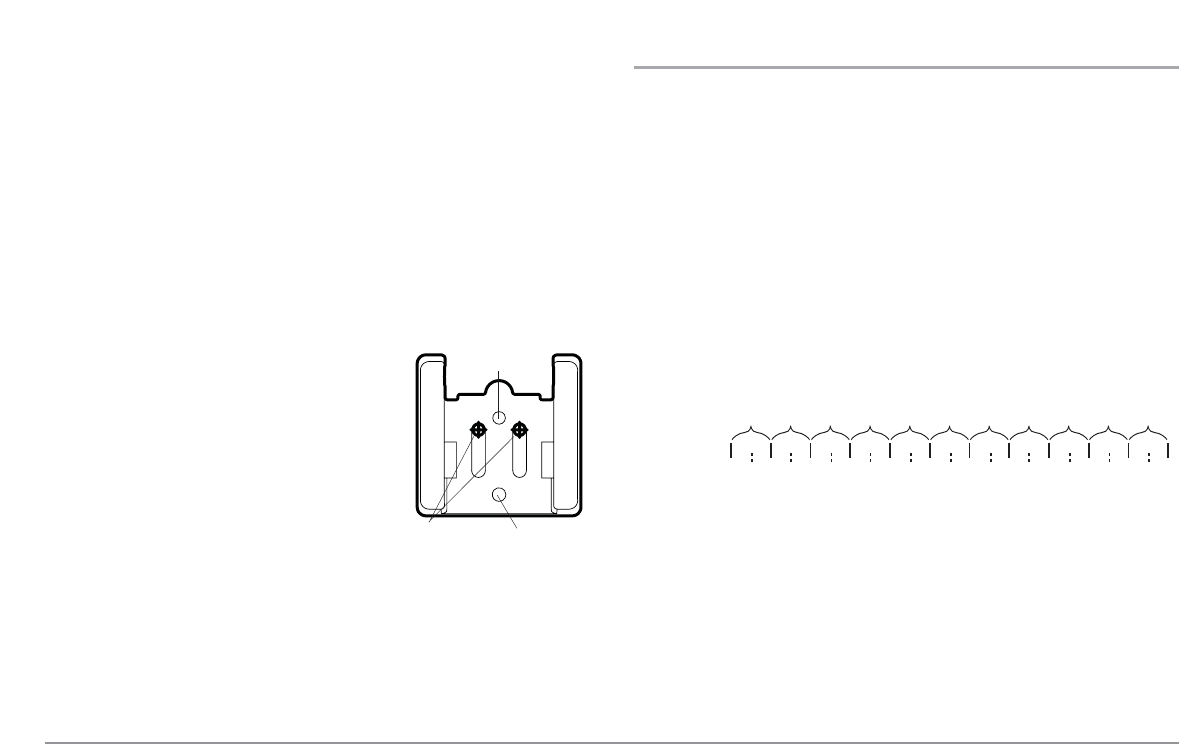
NOTE: If you have a flat-bottomed aluminum boat, some additional adjustment
may be needed to accommodate the rivets on the bottom of the boat (i.e. the gap
may need to be a little smaller than 1/8"). This will help you to avoid excessive
turbulence at high speeds.
NOTE: If your propeller moves clockwise (in forward, as you're facing the stern of
the boat from behind), mount the transducer on the starboard side, and align the
bottom right corner of the mounting bracket with the bottom of the boat. If your
propeller moves counter-clockwise (in forward, as you're facing the stern of the
boat from behind), mount the transducer on the port side, and align the bottom
left corner of the mounting bracket with the bottom of the boat.
3. Continue to hold the bracket on the transom
of the boat, and use a pencil or marker to
mark where to drill the two mounting holes.
Mark the drill holes near the top of each
slot, making sure that your mark is centered
in the slot.
NOTE: The third hole should not be drilled until the
angle and height of the transducer is finalized, which
you will not do until a later procedure.
4. Make sure that the drill bit is perpendicular
to the actual surface of the transom, NOT
parallel to the ground, before you drill.
Using a 5/32” bit, drill the two holes only to
a depth of approximately 1”.
NOTE: On fiberglass hulls, it is best to use progressively larger drill bits to reduce
the chance of chipping or flaking the outer coating.
3. Assembling the Transducer and Initial Mounting
In this procedure, you will assemble the transducer using the hardware
provided, then mount it and make adjustments to its position without locking
it in place.
NOTE: You will initially assemble the transducer and the pivot arm by matching
the two ratchets to a numbered position on the transducer knuckle. Further
adjustments may be necessary.
1a. If you already know your transom angle, refer to the chart below for
the initial position to use to set the ratchets. If your transom is
angled at 14 degrees (a common transom angle for many boats) use
position 1 for the ratchets. In either case, go to step 2.
or...
1b. If you do not know your transom angle, measure it using a plumb line
(weighted nylon string or monofilament line) exactly 12 inches long.
Hold the top of the plumb line against the top of the transom with your
finger, and wait until the line hangs straight down. Using a ruler,
measure the distance from the bottom of the plumb line to the back of
the transom, then use the chart.
NOTE: It is important to take your measurement in the figure showing Measuring
the Transom Angle, from exactly 12 inches down from the top of the transom.
-2 -1 0 1 2 3 4 5 6 7 8 9 10 11 12 13 14 15 16 17 18 19 20 21 22 23 24
Transom Angle (°)
Bead Alignment
Number
142531425
25 26 27
3
28 29 30
1
Measured Distance (x)
1.1cm
1/2“
0.0 cm
0“
2.5 cm
1“
4.3 cm
1 5/8“
5.9 cm
2 3/8“
7.6 cm
3“
9.3cm
3 5/8“
11.1cm
4 3/8“
12.9cm
5“
14.9cm
5 7/8“
16.9cm
6 5/8“
Using the Mounting Bracket
to Mark the Initial Drill Holes
Mark Initial
Drill Holes
Third Hole
Fourth Hole
15


















